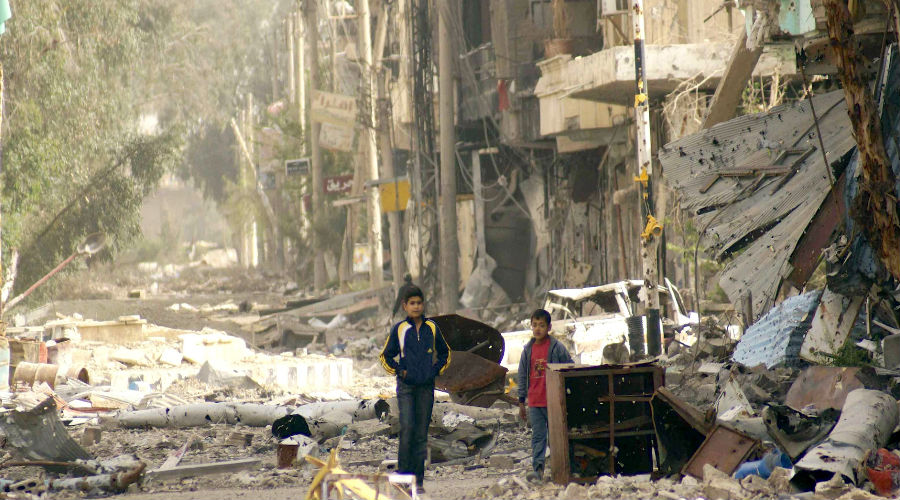Several views in the United States cast doubts on the possibility of taking procedural measures to withdraw troops from Syria in the coming period. The reason is that these were not based on consultations within the U.S. Administration or assessments from competent institutions. Additionally, reactions from major institutions, as well as some world powers, reveal views that oppose the withdrawal. Practically, this potential faces no easy challenges regarding the process of pulling out the U.S. troops and its implications on U.S. policy for regional crises in general and the crisis in Syria in particular.
No doubt, the crisis imposed by using chemical weapons once again in the military attack on Douma City in Eastern Ghouta, will have direct impact on the trajectories of U.S. military presence in Syria, especially after President Donald Trump vowed he will make a quick decision within hours in response to these attacks.
Institutions such as the intelligence, Congress and influential officials of the Administration are likely to put pressures to maintain U.S. military presence in Syria, especially because they believe that withdrawing from the country will mean, for some parties, a defeat to the U.S. This runs in parallel with efforts being exerted by some European states, and France in particular, to persuade the Administration not to take such decision.
Limits of Movement
Parties involved in the trajectories of the U.S. role in the Middle East consider the emergence of this view as a result of failure of the U.S. policy on some regional crises to take a certain shape. In particular, several reports in the past period indicated that Washington was preparing a plan to stay in Syria, form an administration that is independent from Damascus in areas controlled by the Syrian Democratic Forces (SDF) east of the Euphrates River after ISIS is defeated. They also warned against withdrawal from Syria because it would allow the Assad regime and allied parties to seize control of more swathes of territory and can even encourage ISIS to return to areas it previously controlled.
But at the same time, indications emerged that no specific time-frame was announced for withdrawing troops if the U.S. Administration takes a relevant decision. This prompted other views to believe that the Administration is likely to modify the shape and areas of military presence in Syria to deal with the development that occurred on the ground recently as part of the conflict.
The SDF advocated this view. On March 30, 2018, their spokesman Kino Gabriel said that the SDF has not been informed of any plan to withdraw U.S. forces operating in Syria as part of the coalition, and that work and coordination (with the coalition) is continuing in the framework of the support program and joint operations in all regions.
Various Challenges
But this does not negate the fact that there are challenges facing any U.S. efforts to maintain military presence in Syria. Most importantly, the current balance of power in Syria would be changed in favor of the Russian-led bloc including Iran, the Syrian regime and allied militias and Hezbollah in particular. Additionally, some local allied parties are reportedly planning to open communication channels with the Syrian regime to deal with the realities imposed by recent developments. The most important of these developments are military operations carried out by Turkey against Kurdish militias that started in Afrin, as well as the chemical attacks that Douma City came under.
Moreover, there is another problem related to Turkey’s keen interest in continuing coordination and cooperation with the Russian-led alliance. It became evident during the trilateral summit held in Ankara on April 4, 2018, between Turkish President Recep Tayyip Erdogan, Russian President Vladimir Putin and Iranian President Hassan Rouhani, to consult about the potential trajectories of the conflict in Syria in the coming period. The three leaders agreed to hold another summit for which no date was set.
Perhaps, Turkey’s insistence on continuing its military operations in Syria after seizing control of Afrin, and signalling that it is possible to move toward Manbij, has raised concerns in Washington about unprecedented escalation with Ankara. This will apparently play a role in determining the next move by the U.S. in response to the chemical attacks.
Adverse Signs
Washington took a clear position on repeated chemical attacks on some Syrian cities, including, most recently, on Douma City. U.S. President Donald Trump stressed that action must be taken in response to these attacks. Following a meeting with top U.S. military officials, Trump said that within the next 24 to 48 hours, and even earlier, he will take relevant decisions after determining who was responsible for the attacks and whether it’s Russia, the Syrian regime, Iran, or all of them together.
No doubt, there are variables that will play a role in determining the patterns of U.S. action aimed to deal with these developments. It cannot be rule out that the new National Security Advisor John Bolton will have significant influence in this context, especially because he is a proponent of launching military strikes against al- Assad regime. This can be backed by some Congress members and intelligence officials. This also appears to have played a role in claims disseminated by the media on April 9 that the T4 air base in Syria was hit by U.S. missiles, before Russia confirmed that Israel launched the strike.
In conclusion, it can possibly be argued that determining the outline of the U.S. policy toward the developments of the conflict in Syria will, to a certain degree, hinge on any potential consequences of anticipated decisions the U.S. will make in response to the recent chemical attack. These will likely impact the potential political and military trajectories of the crisis in Syria in the coming period.


